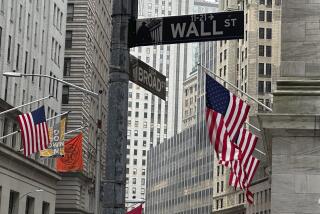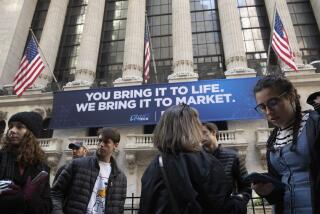Stocks dive and then surge back as U.S.-China trade war escalates

The escalating U.S.-China trade dispute is adding anxiety and confusion to a stock market already on edge over shifting trends in the American economy.
But that doesn’t mean the market’s nine-year bull run is over, as its dramatic rebound Wednesday made clear.
As the United States and China have exchanged a volley of announcements calling for higher tariffs on hundreds of products traded between the countries, stocks have gyrated sharply as investors try to determine whether the dispute could dissipate or get much worse in the coming weeks.
On Wednesday, the Dow Jones industrial average initially plunged more than 500 points after China announced its latest salvo with plans to impose a 25% tariff on an additional 106 U.S. products, including soybeans, autos, chemicals and aircraft.
China’s retaliatory action came a day after the Trump administration proposed a 25% tariff on more than 1,300 imports from China worth an estimated $50 billion.
But the Dow promptly roared back to erase those losses and then tack on a 230.94-point, or 1%, gain for the day to close at 24,264.30 – a 730-point swing for the blue-chip average.
Added to Tuesday’s gains, the Dow’s closing level has surged 620 points, or 2.6%, in the last two days, and Wednesday’s advance was the average’s third gain in the last four sessions. Sandwiched in between was a near 2% drop Monday.
The broader Standard & Poor’s 500 index rose 30.24 points, or 1.2%, to 2,644.69 on Wednesday, and the Nasdaq composite index, which is heavy with technology shares, gained 100.83 points, or 1.5%, to 7,042.11.
The see-saw action in recent sessions shows “the market has a lot to digest these days and now the trade situation is another of those factors,” said Stephen Wood, chief market strategist at Russell Investments.
The trade dispute “adds to the uncertainty and the volatility of a market that’s already seen a spike in volatility this year,” Wood said.
It’s difficult to predict whether the dispute would blossom into a full-blown trade war because the tariffs don’t take effect immediately and it’s expected the United States and China will try to negotiate a much less dire outcome.
“There’s already back-channel talks going on,” Larry Kudlow, President Trump’s new chief economic advisor, told Fox Business on Wednesday.
“I understand the stock market’s anxiety, I get that,” Kudlow said. But he added that “there’s no trade war here. What you’ve got is the early stages of a process” that the White House believes will result in fairer trade with China.
“Don’t overreact,” Kudlow said. “We’ll see how this works out.”
China retaliates against U.S. tariffs, escalates trade war »
The dispute began a month ago when Trump announced tariffs on imported steel and aluminum as part of his effort to reduce the U.S. trade deficit. That prompted China to start imposing tariffs of its own.
The United States had an overall trade deficit with foreign countries of $566 billion last year, up 12% from 2016, and its deficit with China alone was $375 billion last year, according to the U.S. Bureau of Economic Analysis.
Some people see the big trade deficits as inherently bad for American industries and workers, but some economists are not alarmed by the imbalance within the context of the expanding U.S. economy.
For them, growing investment and spending in the United States means businesses and consumers are buying more foreign goods, from crude oil to computers to cellphones.
Regardless, Trump again defended his actions Wednesday on Twitter, saying: “When you’re already $500 Billion DOWN, you can’t lose!”
“We are not in a trade war with China, that war was lost many years ago by the foolish, or incompetent, people who represented the U.S.,” Trump tweeted. “We cannot let this continue!”
Investors fear that if the dispute keeps growing, it could slow U.S. exports of products to China and reduce the sales and earnings growth of the American companies involved.
After an unusually calm 2017 in which stock prices rose steadily, investors this year already were fretting about whether the Republican tax cuts could help lead to higher interest rates and inflation that could pare the appeal of stocks. Recent problems hitting highflying tech stocks such as Facebook Inc. also have weighed on the market.
Before the market’s rally of the last two days, both the Dow Jones industrials and the S&P 500 had dropped 10% or more from their record highs reached Jan. 26, a pullback known as a correction.
But Wednesday’s action showed the market remains resilient, including the tech sector. While Facebook fell 0.7%, Netflix Inc. and Apple Inc. gained 1.9% and Google parent Alphabet Inc. rose 1.2%.
The Dow’s top gainers also were tech stocks, with Microsoft Corp. and IBM both climbing 2.9%.
Seth Kaplowitz, a finance lecturer and expert on international business at San Diego State, said the U.S.-China trade dispute “might escalate a little more,” but he predicted the two sides would reach a negotiated settlement on trade “before it gets imminent that it’s going to damage the world economy.”
Trump “is doing this in an effort to live up to a campaign promise and at the same time force negotiations to take place,” Kaplowitz said. “Any of the patient money players [in the market] will ride this storm out.”
UPDATES:
2:30 p.m.: This article was updated throughout with analysis of the market’s sharp comeback and the U.S.-China trade dispute.
1:10 p.m.: This article was updated throughout with the close of markets.
8:50 a.m.: This article was updated throughout with Times staff reporting, market prices, data on the U.S. trade deficit, President Trump’s tweets and analyst comment.
7:20 a.m.: This article was updated with market prices and context.
This article was originally published at 7 a.m.







